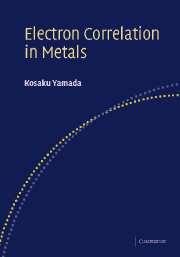Book contents
- Frontmatter
- Contents
- Preface
- 1 Fermi gas
- 2 Fermi liquid theory
- 3 Anderson's orthogonality theorem
- 4 s–d Hamiltonian and Kondo effect
- 5 Anderson Hamiltonian
- 6 Hubbard Hamiltonian
- 7 Fermi liquid theory of strongly correlated electron systems
- 8 Transport theory based on Fermi liquid theory
- 9 Superconductivity in strongly correlated electron systems
- Appendix A Feynman relation
- Appendix B Second quantization
- Appendix C Interaction representation and thermal Green's function
- Appendix D Linear response theory
- Appendix E Transport equation derived by Éliashberg
- Index
7 - Fermi liquid theory of strongly correlated electron systems
Published online by Cambridge University Press: 23 December 2009
- Frontmatter
- Contents
- Preface
- 1 Fermi gas
- 2 Fermi liquid theory
- 3 Anderson's orthogonality theorem
- 4 s–d Hamiltonian and Kondo effect
- 5 Anderson Hamiltonian
- 6 Hubbard Hamiltonian
- 7 Fermi liquid theory of strongly correlated electron systems
- 8 Transport theory based on Fermi liquid theory
- 9 Superconductivity in strongly correlated electron systems
- Appendix A Feynman relation
- Appendix B Second quantization
- Appendix C Interaction representation and thermal Green's function
- Appendix D Linear response theory
- Appendix E Transport equation derived by Éliashberg
- Index
Summary
Heavy fermion systems are explained on the basis of the Fermi liquid theory. The specific heat, magnetic susceptibility and electrical resistivity are discussed. Using Anderson's orthogonality theorem, we show that the Fermi liquid is nothing but a local spin singlet state at every site.
Heavy fermion systems
The Fermi liquid theory is independent of a model Hamiltonian, and can be applied to any system as long as the system remains a Fermi liquid. The theory tells us that even if the electron interaction becomes strong, physical quantities behave as those of the non-interacting Fermi gas. The difference between them with and without interaction is not qualitative but quantitative.
As seen at the Mott transition in Hubbard systems, the effective mass of the electron increases near the transition point. As a system realizing such a large effective mass, a Fermi liquid system called the heavy electron system or the heavy fermion system attracts general interest. The heavy fermion systems are composed of the rare earth metals such as Ce and Yb, and actinide atoms such as U. The heavy fermions are nothing but the quasi-particles in the Fermi liquid theory. As a quasi-particle in a strongly correlated electron system, the heavy fermion is an important issue to be studied in the development of the Fermi liquid theory. The heavy fermion realized in f -electron systems is one of the heavy quasi-particles appearing near the Mott transition.
- Type
- Chapter
- Information
- Electron Correlation in Metals , pp. 122 - 146Publisher: Cambridge University PressPrint publication year: 2004

